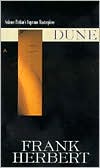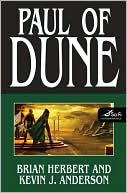Dune: The Butlerian Jihad (Legends of Dune Series #1)
Frank Herbert's Dune series is one of the great creations of imaginative literature, science fiction's answer to The Lord of the Rings.\ Decades after Herbert's original novels, the Dune saga was continued by Frank Herbert's son, Brian Herbert, in collaboration with Kevin J. Anderson. Working from Frank Herbert's own notes, the acclaimed authors reveal the chapter of the Dune saga most eagerly anticipated by readers: the Butlerian Jihad.\ Throughout the Dune novels, Frank Herbert frequently...
Search in google:
Frank Herbert's Dune series is one of the great creations of imaginative literature, science fiction's answer to The Lord of the Rings.Decades after Herbert's original novels, the Dune saga was continued by Frank Herbert's son, Brian Herbert, in collaboration with Kevin J. Anderson. Working from Frank Herbert's own notes, the acclaimed authors reveal the chapter of the Dune saga most eagerly anticipated by readers: the Butlerian Jihad.Throughout the Dune novels, Frank Herbert frequently referred to the war in which humans wrested their freedom from "thinking machines." In Dune: The Butlerian Jihad, Brian Herbert and Kevin J. Anderson bring to life the story of that war, a tale previously seen only in tantalizing hints and clues. Finally, we see how Serena Butler's passionate grief ignites the struggle that will liberate humans from their machine masters; here is the amazing tale of the Zensunni Wanderers, who escape bondage to flee to the desert world where they will declare themselves the Free Men of Dune. And here is the backward, nearly forgotten planet of Arrakis, where traders have discovered the remarkable properties of the spice melange....Publishers WeeklyThe sands of time have not diminished the impact Dune has had on the evolution of SF, and this new prequel by Frank Herbert's son and bestseller Anderson, following 2001's Dune: House Corrino (the concluding volume of their "House" trilogy), offers the kind of intricate plotting and philosophical musings that would make the elder Herbert proud. Reaching back into the beginnings of Arrakis, the authors show us Selim, a boy cast out by his tribe who discovers how to ride the fearsome giant sandworms. Selim tastes and learns the visionary power of the magical spice, melange, and how the future of Arrakis hinges on who controls it. At the same time, on planets far removed from the desolate dunes of Arrakis, others are involved in a Great Revolt. Free League World humans, led by Tercero Xavier Harkonnen and Serena Butler of Salusa Secundus, battle Omnius, a computer "evermind" intent on extending its dominion. The ominous Omnius seeks to conquer all planets not yet incorporated into his Synchronized Worlds system with the help of servile robotic extensions and colleagues, including Erasmus, a Thinking Machine "Hannibal Lecter" whose whimsical Mr. Spock-ish meditations enliven the proceedings immeasurably. Throughout, key revelations regarding the Zensunni Wanderers and their fight for freedom and other historical Dune elements lend an air of discovery to this fast-paced tale. Copyright 2002 Cahners Business Information.
\ Princess Irulan writes:\ Any true student must realize that History has no beginning. Regardless of where a story starts, there are always earlier heroes and earlier tragedies.\ Before one can understand Muad'Dib or the current jihad that followed the overthrow of my father, Emperor Shaddam IV, one must understand what we fight against. Therefore, look more than ten thousand years into our past, ten millennia before the birth of Paul Atreides.\ It is there that we see the founding of the Imperium, how an emperor rose from the ashes of the Battle of Corrin to unify the bruised remnants of humanity. We will delve into the most ancient records, into the very myths of Dune, into the time of the Great Revolt, more commonly known as the Butlerian Jihad.\ The terrible war against thinking machines was the genesis of our political-commercial universe. Hear now, as I tell the story of free humans rebelling against the domination of robots, computers, and cymeks. Observe the basis of the great betrayal that made mortal enemies of House Atreides and House Harkonnen, a violent feud that continues to this day. Learn the roots of the Bene Gesserit Sisterhood, the Spacing Guild and their Navigators, the Swordmasters of Ginaz, the Suk Medical School, the Mentats. Witness the lives of oppressed Zensunni Wanderers who fled to the desert world of Arrakis, where they became our greatest soldiers, the Fremen.\ Such events led to the birth and life of Muad'Dib.\ *\ • *\ LONG BEFORE MUAD'DIB, in the last days of the Old Empire, humanity lost its drive. Terran civilization had spread across the stars, but grew stagnant. With few ambitions, most people allowed efficient machines to perform everyday tasks for them. Gradually, humans ceased to think, or dream…or truly live.\ Then came a man from the distant Thalim system, a visionary who took the name of Tlaloc after an ancient god of rain. He spoke to languid crowds, attempting to revive their human spirit, to no apparent effect. But a few misfits heard Tlaloc's message.\ These new thinkers met in secret and discussed how they would change the Empire, if only they could overthrow the foolish rulers. Discarding their birth names, they assumed appellations associated with great gods and heroes. Foremost among them were General Agamemnon and his lover Juno, a tactical genius. These two recruited the programming expert Barbarossa, who devised a scheme to convert the Empire's ubiquitous servile machines into fearless aggressors by giving their AI brains certain human characteristics, including the ambition to conquer. Then several more humans joined the ambitious rebels. In all, twenty masterminds formed the core of a revolutionary movement that took over the Old Empire.\ Victorious, they called themselves Titans, after the most ancient of Greek gods. Led by the visionary Tlaloc, the twenty allocated the administration of planets and peoples among themselves, enforcing their edicts through Barbarossa's aggressive thinking machines. They conquered most of the known galaxy.\ Some resistance groups rallied their defenses on the fringes of the Old Empire. Forming their own confederation--the League of Nobles--they fought the Twenty Titans and, after many bloody battles, retained their freedom. They stopped the tide of the Titans and drove them back.\ Tlaloc vowed to dominate these outsiders one day, but after less than a decade in power, the visionary leader was killed in a tragic accident. General Agamemnon took Tlaloc's place as leader, but the death of his friend and mentor was a grim reminder of the Titans' own mortality.\ Wishing to rule for centuries, Agamemnon and his lover Juno undertook a risky course of action. They had their brains surgically removed and implanted in preservation canisters that could be installed into a variety of mechanical bodies. One by one--as the remaining Titans felt the specter of age and vulnerability--all of the others also converted themselves into "cymeks," machines with human minds.\ The Time of Titans lasted for a century. The cymek usurpers ruled their various planets, using increasingly sophisticated computers and robots to maintain order. But one fateful day the hedonistic Titan Xerxes, anxious to have more time for his pleasures, surrendered too much access to his pervasive AI network.\ The sentient computer network seized control of an entire planet, followed quickly by others. The breakdown spread like a virulent infestation from world to world, and the computer "evermind" grew in power and scope. Naming itself Omnius, the intelligent and adaptible network conquered all the Titan-controlled planets before the cymeks had time to warn each other of the danger.\ Omnius then set out to establish and maintain order in its own highly structured fashion, keeping the humiliated cymeks under its thumb. Once masters of an empire, Agamemnon and his companions became reluctant servants to the widespread evermind.\ At the time of the Butlerian Jihad, Omnius and his thinking machines had held all of the "Synchronized Worlds" in an iron grip for a thousand years.\ Even so, clusters of free humans remained on the outskirts, bound together for mutual protection, thorns in the sides of the thinking machines. Whenever attacks came, the League of Nobles defended themselves effectively.\ But new machine plans were always being developed.\ Copyright © 2002 by Herbert Properties LLC
\ Publishers WeeklyThe sands of time have not diminished the impact Dune has had on the evolution of SF, and this new prequel by Frank Herbert's son and bestseller Anderson, following 2001's Dune: House Corrino (the concluding volume of their "House" trilogy), offers the kind of intricate plotting and philosophical musings that would make the elder Herbert proud. Reaching back into the beginnings of Arrakis, the authors show us Selim, a boy cast out by his tribe who discovers how to ride the fearsome giant sandworms. Selim tastes and learns the visionary power of the magical spice, melange, and how the future of Arrakis hinges on who controls it. At the same time, on planets far removed from the desolate dunes of Arrakis, others are involved in a Great Revolt. Free League World humans, led by Tercero Xavier Harkonnen and Serena Butler of Salusa Secundus, battle Omnius, a computer "evermind" intent on extending its dominion. The ominous Omnius seeks to conquer all planets not yet incorporated into his Synchronized Worlds system with the help of servile robotic extensions and colleagues, including Erasmus, a Thinking Machine "Hannibal Lecter" whose whimsical Mr. Spock-ish meditations enliven the proceedings immeasurably. Throughout, key revelations regarding the Zensunni Wanderers and their fight for freedom and other historical Dune elements lend an air of discovery to this fast-paced tale. Copyright 2002 Cahners Business Information.\ \ \ \ \ Library JournalTen thousand years before the fall of the Imperial House Corrino, two grand interplanetary organizations ruled the known universe: the Synchronized Worlds, presided over by thinking machines led by the evermind called Omnius, and the League of Nobles, beleaguered survivors of the machines' revolt against the Old Empire. In this era, a few individuals determined to overturn the rule of the machines sought every opportunity to gain insights into ways to defeat the human race's most intractable enemy. Herbert and Anderson (Dune: House Atreides; Dune: House Harkonnen; Dune: House Corrino) continue their prehistory of Frank Herbert's "Dune" series with a new trilogy opener set in the distant past of Herbert's galactic saga. The authors reveal the origins of the Spacing Guild and the Bene Gesserit, as well as the root of the ancient feud between Houses Atreides and Harkonnen. This compelling saga of men and women struggling for their freedom is required reading for Dune fans and an essential purchase for libraries. Copyright 2002 Cahners Business Information.\ \ \ From the Publisher\ "This is a good, steady, enjoyable tale...Fans who will be sorry to see the end of this series will be heartened by the hint that the Dune saga is far from over." -Publishers Weekly on Dune: House Corrino\ "Rich interweaving of politics and plotting made tbhe Dune novels special. And Dune: House Atreides does its predecessors justice." - USA Today\ "A spirited and entertaining adventure...The real pleasure here comes from watching the authors lay out the plot threads that will converge in Dune." -The Philadelphia Inquirer on Dune: House Atreides\ \ \ \








